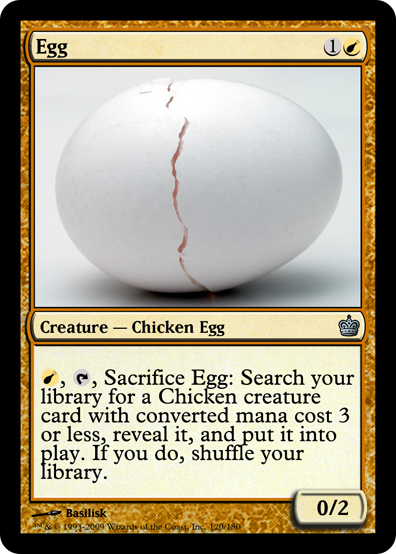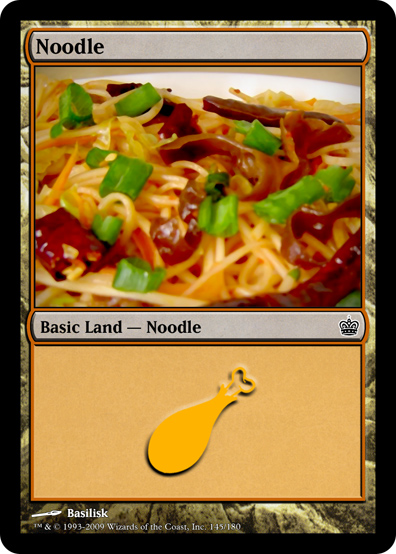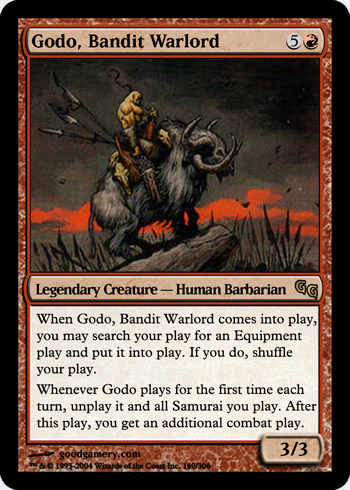
Oracle Rulings
10/4/2004: It must flip like a coin and not like a Frisbee.

Oracle Rulings
10/4/2004: It must flip like a coin and not like a Frisbee.
Welcome to the premier issue of Sorcerer Magazine — Dominaria’s only newspaper about Sorcerers, Sorcery, and Sorcerous happenings.
Sorcerers are very similar to Wizards, although they have much longer hair, and perfer Sorceries as their primary type of magical spell. They are also known for their sweeping robes and unending vanity.
In this first-of-its-kind issue, we sent one of our foremost investigative journalists to talk face-to-face with the various Sorcerers inhabiting downtown Alara. What he found out is so sorcerous that we were legally obligated to print it by the Sorcerer’s Guild! Let’s take a closer look at the day-to-day life of these strange creatures.

“Nyyaaa!
With this spell, I can destroy two ceiling lights at the same time. It’s all part of my plan to promote ground lighting, which accentuates my features in a way candelabras never could.”

“Wow, this book is great! Wait, don’t turn the page yet – I’m not done reading it.
Ok, now you can turn.”

“When I was younger, I fell down (while skateboarding, if you must know) into a pile of glowing blue gems.
Since that day, I have never needed to sleep with a nightlight. I consider this my most powerful ability.”

“Could we get a red spotlight on my bare chest, please? These arcs of electricity are making me look pale.”

“I have spent much of my life researching how to control the element of water — summoning it from thin air, making it fly twixt this place and that, bending the raw power of nature to my own will!
I no longer have need for dixie cups or water balloons.”

“Can someone help me out? I got my arms stuck in this thing while I was trying to change the batteries.”

“I’m tired of magazines
Sayin’ flat butts are the thing,
Take the average elemental and ask him that
She gotta pack much tree”
So, fellas! (Yeah!) Fellas! (Yeah!)
Has your girlfriend got the tree? (Hell yeah!)
Tell ’em to shake it! (Shake it!) Shake it! (Shake it!)
Shake those healthy leaves!
Baby got tree!

“Whenever my kids visit it’s only to get +1/+1 until the beginning of the end step.”
More in this issue:
“Welcome to my innermost library of secret scrolls – you’ve been such a studious pupil all along, and so full of life! Since we both already know you’re here to learn more about Magic, let’s cut right to it. Ah ah ah!”

1. Cast a creature spell in your first main phase to trick your opponent into thinking you had your combat phase already.
2. Whenever your opponent casts a spell, make sure to touch a couple of your lands and make like you’re about to say something, but don’t. What were you about to do? Your enemies will keep guessing, but ever wrongly!
3. When tapping for mana, put a couple extra in your mana pool. You will never know when you might need it later, and your opponent will forget about it until it’s too late.
4. Every cantrip in your deck is equivalent to a land, so you can swap them out one for one. Good examples include [card]Bandage[/card], [card]Zap[/card], and [card]Aphotic Wisps[/card].
5. [card]Land Grant[/card] works best in decks where you are unlikely to get land in your opening hand (or hands where you have a [card]Gemstone Caverns[/card]). Load up on both and forsake normal lands.
6. If you’re playing White and keep losing to decks that have creatures attacking you, pack your deck full of Circles of Protection. This quick cover will allow you to sit back and relax while your enemies ram their men into your Circles. Eventually, you’ll draw a big spell you can use to win against your opponent’s army.
7. Play as many colors as you can, to make sure you have a card for every situation that may crop up. You never know who is going to show up and challenge you to a duel, and as a bonus, playing lots of colors will keep [card]Angry Mob[/card] from wrecking you.
8. If you’re dueling in a location with bright lights, make sure to use all foil lands from different sets and with different borders. Due to this shimmering distraction, your fellow wizards won’t be able to survey your available mana effectively. Since you’ll have tested your deck beforehand, you will be immune to its blinding effects.

9. Once you have a couple lands in play, keep a couple in your hand and bluff that you’re holding useful spells. Make sure to look at them sideways to make it more convincing, since the only reason someone would do that is if it’s a split card. Since a crafty black wizard might try to [card]Mind Rot[/card] you, add a [card]Library of Leng[/card] to your deck. This will keep them from seeing the cards in your hand.
10. You can cast [card]Vampiric Tutor[/card] to search for, you guessed it — another Vampiric Tutor. This will put the mind-screws on an opponent while you rack up dozens of virtual cards in your virtual card advantage IRA.
“My most valuable student, it seems you’ve run out of life… you were so close to winning the next GP, too.”
At those words, your Vampiric Tutor changes into a bat and flies away as you crumple to the floor, a bloodless husk!
Recently, my living situation has aligned itself in just such a way that I have developed an interest in cooking. I’m coasting along on what money remains until I return to America in a couple months, want to learn Japanese dishes while in the little time I have left, and want to supplement my newfound exercise habits with healthy meals.
I am a dude with a Jewish mom, so I have quite literally never had to fix anything more ambitious than a sandwich or an omelet. Cooking can be daunting at first! Luckily, most Japanese staples are incredibly simple to make, healthy, and cheap. Tonight, I made:
Oyakodon – steamed white rice, topped with chicken, egg and onions served in traditional Japanese dashi broth.
For the unfamiliar, donburi is a dish made from rice, broth or water mixed with soy sauce and rice vinegar, and various toppings. Donburi is as filling as it is delicious, and generally requires less than 30 minutes to prepare.
1 cup of Japanese white rice
1/2 onion
1.5 tbsp dark (regular) soy sauce
1 tbsp mirin (Japanese rice vinegar)
1/2 cup water
1 tbsp sugar
1 tsp dashi (powdered soup stock made from kelp and skipjack tuna, a fundamental ingredient for Japanese cooking, including miso soup)
~1/4 cup chicken thigh; enough for about 6 bite-sized chunks
1 egg

RICE: Wash your rice a few times until the water isn’t cloudy, but don’t worry too much, as cloudier rice is just stickier rice.
Combine one and a bit cups of water for each cup of rice you make in a pot.
Cover the pot with a lid, and bring the rice to a boil on high heat.
Then, cook it on low for about 15-20 minutes, until the water is mostly gone.
Remove the pot from the fire, and let it steam with the lid on for another 10-15 minutes.
Or, use a rice cooker. Seriously.
ONION: cut off the narrow ends of the onions. Place it flat on the cutting board, slice it in half, and remove the skin. Wrap one half in aluminum foil and put it back in the fridge, because you are poor. place the other half on its broad, flat side, and cut it widthwise into ~5mm strips.
CHICKEN: remove any bones and skin from your thigh meat, rinse it, and cut it into bite-size portions.
EGG: beat an egg.
BROTH: combine the dashi, soy sauce, water, rice vinegar, and sugar in a pan.
Mix the ingredients, cover the pan, bring the heat to medium, and leave the mixture for a minute or two.
When the broth is hot and uniform, remove the lid and stir in the onion before replacing the lid again.
After another couple minutes, stir in the chicken and put the lid back on.
Wait a couple minutes to turn over the chicken, and when it’s cooked on both sides, stir in the egg; make sure it doesn’t stay together enough to form any large pieces.
Pour the mixture over your bowl of rice. Congratulations! Enjoy your delicious donburi with chopsticks and a spoon.
Without further ado, here is how the tournament went.
He opens with a pile of steaming broiled noodles topped with rare beef and oblique cut green onions. I lay an egg and pass the turn. He picks up his chopsticks and swings with a slice of beef and a hank of noodles, spraying beef juice over my board for -1/-1. I crack the egg and fetch a chicken equipped with makotobashi. I lay a scoop of white rice and top it with a drizzle of soy and vinegar. He draws 4 noodles in a row and scoops his lunch.
Second game much like the first, except now I’ve found my onions and my onions trample over his onions and take his beef.
1-0

This is a variant on the popular Japanese deck substituting G avocado for R snapper. Basically he rolls over me as I try to find a protein source and fail.
1-1
I am quite surprised that this is still seeing play. I’m having trouble getting past the cheese and garlic but eventually rice proves a more stable mana base than rye. First game I lose horribly to garlic. Second game I side out onions and chicken and throw in 4x pickled egg and 3x wasabi. Even though he has slathered the red zone with butter and garlic cheese, the wasabi comes down hard and fast, and burns his sinuses right out. Game 3 I go rice, egg, 2x wasabi and he offers the handkerchief.
2-1
This is Swiss final round and I’m tired, thirsty, and have a runny nose. E. Honda entered the tournament with a 2050 rating and 1 point shy of a 3-bye invite to GP Bangkok. He is piloting a new, unscouted version of his trademark midrange toolbox Nabe deck, and is an impeccably technically precise player despite his quirky tournament attire of bath towel and geta. He clomps over to the table, settles his 270 kg frame into the tiny folding chair, and smiles.
Game 1 saw me get a good start with Rice, egg, 2 chickens and a dash of vinegar. He seems to have trouble finding a black mana but manages a turn 3 norimaki and starts laying out some serious fat. I am pinging in the air thinking this will be a long but inevitable game. Then he sacs potato, norimaki, crab, tuna, and mushroom to get Mothra. I try to distract the giant with Wasabi but remember as Honda untaps that moths can’t smell.
Game 2 I side out 4x mirin and side in 4x Kirin.
We are both getting drunk but I am secretly taking pings from my own Wasabi and it keeps me alert enough to outmaneuver Honda, who is by this time sleepy drunk and has to get up to pee. He has taken 3x Kirin to the face and looks like he is about to pass out as the judges watch him lurch for the washroom. After several minutes he returns, red in the face and somewhat more alert. But it has cost him momentum and he fails to deal with 100 stings from wasabi + raw onion.
Game 3 I start out with Kirin. Rough on the stomach this early in the game, I am getting low on life and it seems he has developed a tolerance. I keep at it though, and finally he is so drunk he can’t remember whether he has untapped this turn and forgets a bunch of may effects during his upkeep. I go all-in with a sick chicken and he folds. Literally. His folding chair finally collapses, he goes down, tries to get back up, and is down for the count as the judges wander by to keep him from falling asleep in the aisle.
3-1
I gotta go pee so bad, I miss the final standings but hear later on I was just shy of top 8.
Last month, Wizards of the Coast announced a salient set of rules changes. Although many of these changes are superficial, one in particular is not; combat damage now uses the stack. While events like these can be expected to raise cries that Magic is dying among scrubs, even more cogent veterans expressed unhappiness at the change.
“The change removes decisions a lot of interesting decisions from the game,” commented one player. “Consider blocking [card]Savannah Lions[/card] with a [card]Sakura Tribe Elder[/card]. Under the old rules I had to make a choice between trading and getting a land, but now there will simply be only one correct play. I understand their desire to make the game more accessible to newer players by removing the unintuitive waterfall damage system but they’ve done it at the cost of dumbing down the game for competitive players.
“The changes don’t even make sense from a flavor perspective either,” he continued, “under the new rules if I triple block a [card]Dauntless Escort[/card] with [card]Scion of Oona[/card] the attacker can split the damage and kill all my guys. How does that even make sense at all? Is it that when the Scion dies his buddies are torn up about it and suddenly realize that their wounds are lethal? And how does [card]Nantuko Husk[/card] fight some dude and then eat one of his buddies who was just fighting at the same time only his buddy still kills the dude he was fighting and husk survives? Two [card]Ravenous Baloth[/card]s engage in a fight to the death and then both commit ritual suicide in order to avoid dying normally? What?”
Although many competitive players believe that the changes give them fewer opportunities to outplay their opponents during the combat phase, others point out that these opportunities have just shifted from declaring the order of blockers to damage assignment.
“I’m really surprised that people are getting worked up about this, if you play with the new rules for a bit you’ll see that the changes are pretty minor and don’t come up very often,” said another player who acknowledged that he was going to miss windmill slamming his cards ‘onto the battlefield’.
Pro MTG Online #226
Pro MTG Online #225
Facing an overwhelming force intent on expansion, redrawing the map and its resettling and modernizing its traditional homelands, the Elder of the Sakura Tribe has declared an end to years of armed retreat and asymmetrical warfare by surrendering to Magic: The Gathering rules manager Mark Gottlieb. The surrender took place on October 5, at Miren, the Moaning Well (now a national historic site), about 40 miles south of the Canadian border.
While the Sakura Tribe has responded to repeated attacks by giving up its traditional lands for years, it had long engaged in a practice of putting damage on the stack, wherein a rear guard would inflict a single point on the advancing army before committing ritual suicide. This practice made the tribe folk heroes among many Magic players, who, while they still settled into the seized lands, applauded the snakes’ courage, resourcefulness, and ability to keep counters off Umezawa’s Jitte.
“I always liked Steve,” said powerful wizard and Baylor College freshman Ankur Kartamian, using the common racial epithet for the tribe. “He was a good man, a common man. Sometimes he even got there, but mostly, he showed us to die as we lived, and to never make a choice between the two.”
“I am deeply saddened by his surrender,” added Kartamian’s roommate Mitchell Hart, as he tapped seven of the tribe’s ancestral mountains, plains and islands to cast a Bull Cerodon and have it enter the battlefield, “Some of us are getting together to protest this. We are considering a strongly worded e-mail, or maybe quitting Magic.” Hard then ordered Kartamian’s blockers and cast Unsummon before damage for a 2-for-1.
The Elder’s surrender was as eloquent as it was saddening:
Claims that this speech was written by Wizards of the Coast poet laureate Doug Beyer, and not in fact by a playing card with a snake on it, remain unconfirmed.
Gottlieb responded to his longtime foe with a knowing respect, “It is true, many of the Elder’s children have left the battlefield and gone into exile. And I wish we had made this change earlier, before so many of the Sakura Tribe had to die. But this game has a bright future; a Manifest Destiny.
The Sakura tribe is part of that destiny. It is very hard to explain to our own children the lives that are lost in what is already a decided conflict. It is merely the march of history. To live together as one people, we must put an end to these senseless murder-suicides, as courageous as they may be.
Or else the whole country might collapse, replaced by a larger budget for Monopoly or other such bullshit.”
“You just watch,” said Sachi, daughter of Seshiro, a longtime advocate for a more violent, fireball-based Orochi policy. “This will change nothing. The Sakura Tribe will keep getting played and killed by the white man and giving him land until there is none left in its library. This amicable surrender is just a fog effect for genocide. The only choice our Elder has made is to die rather than fight.”
While the exiled Orochi were promised basic land, rumors are flying they have instead been forcibly relocated to the Dust Bowl.
“Whatever the damage this has caused, it has been assigned, and it is now too late to prevent it,” mourned Sachi.
With big changes coming in 2010, now is a great time to look at the past to help contextualize the new framework of magic. In this series, we’ll consider an area being updated in 2010, trace it back to its earliest roots, and look at what 2010 means to its future.
Alpha — Ice Age
Cards were often printed with their initial inspired-by-fantasy-flavor wording, with any revisions or clarifications tacked on the end rather than represented by edits. As a result, it was common to see effects such as “Draw an extra land or spell from your library in addition to your normal draw for the turn, but only once a turn, and not if your hand is full already or you didn’t pay 4 mana.”
Ice Age — 6th Edition
Designers get tired of magic cards that sound like your drunken uncle trying to tell a joke he barely remembers, and standardize the wordings of common effects and meanings. Now all the cards with the same intended effect say the exact same thing, except the 90% of those cards printed either before this standardization or after one of the several changes to the standard in question.
6th Edition — 2010’s Paper Release
Flavor takes a back seat to functionality in card wordings. Terms are further standardized, and evocative fantasy words are replaced with mundane gaming ones. For instance, ‘cast’ becomes ‘play.’ Unfortunately, due to a rather severe editing error, the words ‘tap,’ ‘control,’ ‘card,’ ‘phase,’ ‘attack,’ and most confusingly ‘library’ also become play. Thus prompting Noam Chomsky to famously declare [card]Godo, Bandit Warlord[/card]’s text…

… to be “completely friggin’ indecipherable.”
2010’s paper release — 2010’s MTGO release
Evocative fantasy words return in greater numbers than ever before! This brings an end to the confusion over how coming into play is different from being played, and replaces it with confusion over how three islands and an underground river can be in a field.
2010’s MTGO release — ???
Due to a strconst.dat error, words on cards will be chosen almost entirely at random.
Alpha — Legends
In keeping with the fantasy-flavor-driven motif, mana is conceived as magical energy drawn from the land – wild and not easily contained. Likewise, mana burning is conceived as absentmindedly leaving the eldritch stove on and setting your arcane house on runic fire.
Legends — 6th Edition
The game checks to see if you are mana burning at the end of each phase, but only checks to see if you’re dead every turn. Because of these questionable priorities it becomes popular to intentionally burn yourself to death, then later reveal that the game takes place in a mirror universe where it is actually the opponent that has been dead all along. Although this strategy never won any major tournaments, its supporters were vindicated when the film adaptation was nominated for 6 Oscars.
6th Edition — 2010’s Paper Release
Death makes up for lost time and starts killing people at 0 life any time anyone has priority. Mana burn keeps up its steady pace of once a phase. R&D members realize they can create cards that use mana burn as a weapon or a balancing drawback. This epiphany opens up fascinating design space for upwards of 4 cards, which range from “sort of ok” to “reasonably good I guess?”
2010’s Paper Release — 2010’s MTGO Release
Instead of mana burn arbitrarily taking effect at the end of each phase, it will arbitrarily take place at the end of each step, or it would if it existed at all. Previous cards built partially on mana burn degrade from their previous quality to “nothing special” and “meh, it’ll do.”
2010’s MTGO Release — ???
Whenever you pass priority with mana in your pool, a dialogue box will appear asking, “do you want to take mana burn?” If you click “no” you will retain priority. If you click “yes” you’ll be removed from the event for cheating and your account will be suspended pending administrative review.
Alpha — Mirage
Combat damage and its prevention or mitigation do not use “the stack.” Instead, there is a plethora of various reactive sub-steps for damage prevention. For example, whenever a creature is played, there is immediately a sub-step in which you can pay 2 mana to prevent it from ever doing damage. If you elect not to, you’ll enter a series of steps and phases where you can pay 1 mana to nullify its ability to deal damage. Finally, if a creature somehow entered combat, its damage was immediately dealt, after which point you had one last chance to prevent its damage. As previously noted though, there was no real rush even then, as you still had a whole turn to gain that life back before anyone noticed.
Mirage — 6th Edition
Catino’s infamous [card]Grave Servitude[/card] ruling at PT Atlanta sets precedents that will be pivotal to the priority and the stack understanding of magic. The idea of judges interpreting and creating the rules in the middle of a high level event may seem unpleasantly arbitrary and unpredictable to neophytes, but savvy pros know you can count on them to make decisions along party lines 95% of the time.
6th Edition — 2010’s Paper Release
Alarmed by its loss of market share in the adolescent boy demographic to other collectible games, Wizards re-directs its marketing to Turing-complete machines. Abilities use a first-in-last-out stack to resolve. The game no longer contains unique, reactive batches and sub-steps; each step and phase operates in the same basic fashion. Play is accomplished by explicitly passing the right to use actions several dozen times per turn. Combat damage is now an object that takes time to process and exists independent of the source it is referencing. People looking to enjoy a casual game complain that only a computer program could process these painfully rigid rules in their stated form. Unfortunately, they are widely discredited when repeated attempts to create such a program fail miserably.
2010’s Paper Release — 2010’s MTGO Release
While the stack is still seen as a positive device, combat damage using it is deemed too confusing to new players. In order to remedy this, a system in which combat damage is dealt upon assignment is instituted, which renders damage prevention and regeneration terribly unintuitive. In order to remedy this, an unintuitive damage-prioritizing system is instituted which renders deathtouch terribly unintuitive. In order to remedy this, the system unintuitively doesn’t apply to deathtouch. Because of this corner case, the war is lost, and all for want of a nail.
2010’s MTGO Release — ???
Changes function exactly as intended; are reported broken by hundreds of players unfamiliar with the new rules.
Pro MTG Online #224